Characterization of a New Lightweight Plaster Material with Superabsorbent Polymers and Perlite for Building Applications
Abstract
1. Introduction
2. Materials and Methods
2.1. Materials
2.1.1. Binder
2.1.2. Water
2.1.3. Potassium Polyacrylate
2.1.4. Perlite
2.1.5. Fibers
2.2. Experimental Program
- Bulk density by weight of 4 × 4 × 16 cm plaster test specimens.
- Determination of the mechanical resistance to bending and compression using an IBERTEST servo-hydraulic testing machine and WinTest software, following the recommendations of the UNE-EN 13279-2:2014 standard [2].
- X-ray diffraction (XRD) using Siemens D5000 equipment. This test was carried out with a sample of previously ground and sieved (0.0125 mm mesh light sieve) material of approximately 50 mg and with a Cu-kα graphite monochromator, obtaining diffractograms for a range of 5° ≤ 2θ ≤ 100° every 0.04° and 4 s per step. The crystalline phases were identified using the International Center for Diffraction Data Powder Diffraction Files database (ICDD PDF).
- Thermogravimetric analysis (TGA) using a TA Instruments SD Q600, together with Universal Analysis 2000 software. This test was performed on a sample of previously ground and sieved (0.0125 mm mesh size sieve) material of approximately 50 mg, raising the sample temperature from approximately 20 °C to 900 °C with increments of 10 °C/min, under an air flow rate of 100 cm3/min.
- The determination of the setting time of the plaster mass in the fresh state using a Vicat needle and surface hardness of the 4 × 4 × 16 cm specimens using a shore C hardness tester, according to UNE-EN 13279-2:2014 [2].
- Height reached by the water after the capillary absorption test for the 4 × 4 × 16 cm samples according to UNE-EN 459-2:2011 [47].
- The determination of the coefficient of thermal conductivity via the thermal box method, using four thermocouple sensors and Measure software for specimens of dimensions 24 × 24 × 2 cm, according to UNE-EN 12859:2012 [48].
- Adhesion test on ceramic surfaces using a ceramic brick board previously moistened with water and then metal discs of 50 cm diameter glued with epoxy resin and a detachment testing machine, according to UNE-EN 13279-2:2014 [2].
- The determination of mechanical flexural and compressive strengths using an IBERTEST servo-hydraulic testing machine and WinTest software, following the recommendations of the UNE-EN 13279-2:2014 standard [2].
- The determination of the viability of the above compounds to produce suspended ceiling panels. Samples of dimensions 1.5 × 30 × 40 cm were prepared and tested with the help of a bending machine model Proeti. S.A., following the recommendations of the UNE-EN 13279-2:2014 standard [2].
- Scanning electron microscopy (SEM) using a high-resolution microscope model Nova Nano SEM230 (FEG-SEM) with a resolution of 132 eV. All fragments analyzed were obtained, guaranteeing an unmodified surface texture. The samples were coated with a thin layer of gold using a Cressington 108 metallizer in order to ensure good conductivity to the electron beam generated by the equipment.
3. Results
3.1. First Experimental Phase. Determination of the Water/Plaster Ratio and Proportion of Potassium Polyacrylate and Perlite
3.2. Second Experimental Phase. Characterization Tests of the New Fiber-Reinforced Plaster Material
3.2.1. Chemical Characterization
3.2.2. Physical–Mechanical Characterization
4. Conclusions
- Regarding the initial characterization, it can be concluded that the combined action of perlite and potassium polyacrylate in the mixture reduces the density of the plaster composites by up to 28.5%. It can also be observed that a lower water/binder ratio by weight results in a higher flexural and compressive strength of the hardened material. Among all the mixes produced, the E35-0.7-15-30 mix exhibits the best technical performance. Thus, it has been possible to reduce the density and obtain a plaster material that can be competitive in the market for use as a prefabricated product, aligning with other research using gypsum plaster composites for building applications [60].
- Regarding physicochemical characterization, X-ray diffraction reveals a similar crystalline structure for both the mixes with additions and the reference mix. However, thermogravimetric analysis demonstrates that the incorporation of perlite and potassium polyacrylate results in less mass loss of the material at temperatures below 200 °C. At temperatures below 100 °C, the loss of mass associated with mixing water is not appreciable. On the other hand, at temperatures above 200 °C the new material exhibits slightly higher mass loss compared to the reference plaster. Between 200 and 300 °C, there is a loss of mass due to the endothermic oxidative decomposition of potassium polyacrylate. Additionally, between 425 and 550 °C, the exothermic oxidative decomposition of the organic polypropylene and wood fiber leads to a slight further mass loss of the material.
- As for the physical properties of the new material developed, it has been verified that the plaster material lightened with perlite and potassium polyacrylate (NF) has a thermal conductivity coefficient 46.63% lower than traditional plasters (REF). This decrease in thermal conductivity is attributed to a 10.44% reduction in the density of the plaster compound produced compared to the reference plaster E0.7.
- The results obtained for flexural and compressive strength in all the produced dosages for the plaster lightened with fibers surpass the minimum value established by the reference standard (1 MPa in flexural strength and 2 MPa for compressive strength). It should be noted that the incorporation of reinforcement fibers, both synthetic and natural, means an increase in the mechanical capacity of the material produced, leading to an improvement in the flexural strength of the hardened composite. In the case of flexural strength, the incorporation of glass fiber exhibits the best results, decreasing the strength value by 24.6% compared to traditional plaster down to 15%. In compressive strength, this reduction is more notable, as the perlite and the polymer cause the new material to resist 52.52% less than the plaster currently used.
5. Patents
Author Contributions
Funding
Data Availability Statement
Acknowledgments
Conflicts of Interest
References
- Pinto, N.; Fioriti, C.; Akasaki, J.; Acunha, T.; Okimoto, F. Rendimiento de compuestos de yeso que incorporan partículas de neumáticos de goma. Rev. Ing. Construcción 2020, 35, 216–232. [Google Scholar] [CrossRef]
- Vega, D.F.; Fernandez, C.M.; Sánchez, E.A.; Martínez, P.S. Material de Escayola de Rápido Fraguado y Aligerado Con Polímero de Granza, ES2781675. 19 June 2020. Available online: https://es.espacenet.com/publicationDetails/biblio?CC=ES&NR=2781675A1&KC=A1&FT=D&ND=3&date=20200904&DB=&locale=es_ES (accessed on 24 May 2023).
- Viñas, J.L.G. Nuevas Aplicaciones de Recursos Yesíferos: Desarrollo, Caracterización y Reciclado. Ph.D. Thesis, Universidad Politécnica de Madrid, Escuela Técnica Superior de Ingeniería de Minas, Madrid, Spain, 2005. [Google Scholar]
- Vega, D.F.; Fernandez, C.M.; Dorado, M.Á.; Martínez, P.S.; Material de Escayola Aligerada con Polímeros Para Uso en Placas y Paneles Prefabricados. ES2722598; ES2722598. 2019. Available online: https://worldwide.espacenet.com/publicationDetails/biblio?FT=D&date=20190813&DB=&locale=en_EP&CC=ES&NR=2722598A1&KC=A1&ND=5 (accessed on 13 August 2019).
- Santos, P.; Mateus, D. Experimental assessment of thermal break strips performance in load-bearing and non-load-bearing LSF walls. J. Build. Eng. 2020, 32, 101693. [Google Scholar] [CrossRef]
- Directiva 2012/27/UE del Parlamento Europeo y del Consejo. Boletín Oficial del Estado. 2012. Available online: https://www.boe.es/doue/2012/315/L00001-00056.pdf (accessed on 25 October 2012).
- Ohene, E.; Chan, A.P.C.; Darko, A. Review of global research advances towards net-zero emissions buildings. Energy Build. 2022, 266, 112142. [Google Scholar] [CrossRef]
- Rodríguez, Y.J.R. Caracterización Físico-Mecánica del Yeso de Construcción con Adición de Residuos de Poliestireno Extruído y Residuos Cerámicos. Master’s Thesis, Universidad Politénica de Madrid, Escuela Técnica Superior de Edificación de Madrid, Madrid, Spain, 2015. [Google Scholar]
- Duarte, P.C.; Nakao, F.; Ortenzi, A. Integrated product development and lifecycle management in building production—A case study for logistic of mortar distribution in building sites. J. Build. Eng. 2020, 32, 101802. [Google Scholar] [CrossRef]
- Mucha, M.; Mroz, P.; Wrona, D.; Konca, P.; Marszalek, J. Microstructural formation of gypsum by setting in the presence of hydroxypropyl methylcellulose (HPMC). J. Therm. Anal. Calorim. 2020, 147, 1107–1113. [Google Scholar] [CrossRef]
- Luan, W.; Weixin, D.S.; Veeramasuneni, S. Panel de Yeso Resistente al Fuego de Poco Peso y Densidad. ES2699227T3. 2019. Available online: https://worldwide.espacenet.com/patent/search/family/046001717/publication/ES2699227T3?q=ES2699227 (accessed on 8 February 2019).
- Astorqui, J.S.C.; del Rio Merino, M.; Saez, P.V.; Porras-Amores, C. Analysis of the relationship between density and mechanical strength of lightened gypsums: Proposal for a coefficient of lightening. Adv. Mater. Sci. Eng. 2017, 2017, 7092521. [Google Scholar] [CrossRef]
- Jianxin, Y.L.C. Preparation Method of Heat-Insulation Type Plastering Anhydrite. 2019. Available online: https://worldwide.espacenet.com/patent/search/family/065674275/publication/CN109467378A?q=CN109467378A (accessed on 15 March 2019).
- Pedreño-Rojas, M.A.; Morales-Conde, M.J.; Pérez-Gálvez, F.; Rodríguez-Liñán, C. Eco-efficient acoustic and thermal conditioning using false ceiling plates made from plaster and wood waste. J. Clean. Prod. 2017, 166, 690–705. [Google Scholar] [CrossRef]
- Vidales-Barriguete, A.; Santa-Cruz-Astorqui, J.; Piña-Ramírez, C.; Kosior-Kazberuk, M.; Kalinowska-Wichrowska, K.; Atanes-Sánchez, E. Study of the Mechanical and Physical Behavior of Gypsum Boards with Plastic Cable Waste Aggregates and Their Application to Construction Panels. Materials 2021, 14, 2255. [Google Scholar] [CrossRef]
- Vega, D.F.; Fernández, C.M.; Dorado, M.Á.; Miragaya, P.G. Material de Construcción Aligerado Para la Elaboración de PREFABRICADOS. ES2841130. 2021. Available online: https://es.espacenet.com/publicationDetails/biblio?DB=es.espacenet.com&II=0&ND=3&adjacent=true&locale=es_ES&FT=D&date=20210707&CC=ES&NR=2841130A1&KC=A1 (accessed on 7 July 2021).
- Rahman, M.M.; Jyoti, L.T.Z.; Paul, S.; Al-Ishmam; Hossain, M. A. Mechanical and Thermal Performance of Cement Mortar Incorporating Super Absorbent Polymer (SAP). Civ. Eng. J. Tehran 2020, 6, 2231–2244. [Google Scholar] [CrossRef]
- Kang, S.-H.; Hong, S.-G.; Moon, J. The effect of superabsorbent polymer on various scale of pore structure in ultra-high performance concrete. Constr. Build. Mater. 2018, 172, 29–40. [Google Scholar] [CrossRef]
- James, J.D.; Ludwick, J.M.; Wheeler, M.L.; Oyen, M.L. Compressive failure of hydrogel spheres. J. Mater. Res. 2020, 35, 1227–1235. [Google Scholar] [CrossRef]
- Thompson, B.R.; Horozov, T.S.; Stoyanov, S.D.; Paunov, V.N. Hierarchically porous composites fabricated by hydrogel templating and viscous trapping techniques. Mater. Des. 2018, 137, 384–393. [Google Scholar] [CrossRef]
- González, S.G.; Carpintero, V.C.; Saiz, Á.R.; Saiz, J.G.; Petrement, C.J.; López, J.G. Procedimiento de Obtención de Placas de Yeso Laminado Aligeradas con Residuo de Espuma de Poliuretano, Placa Obtenida y Uso de la Misma. ES2522792; ES2522792; ES2522792. 2014. Available online: https://es.espacenet.com/publicationDetails/biblio?CC=ES&NR=2522792A1&KC=A1&FT=D&ND=7&date=20141118&DB=&locale=es_ES (accessed on 18 November 2014).
- El Mir, A.; Nehme, S.G.; Assaad, J.J. Durability of self-consolidating concrete containing natural waste perlite powders. Heliyon 2020, 6, e03165. [Google Scholar] [CrossRef] [PubMed]
- Vyšvařil, M.; Pavlíková, M.; Záleská, M.; Pivák, A.; Žižlavský, T.; Rovnaníková, P.; Bayer, P.; Pavlík, Z. Non-hydrophobized perlite renders for repair and thermal insulation purposes: Influence of different binders on their properties and durability. Constr. Build. Mater. 2020, 263, 120617. [Google Scholar] [CrossRef]
- Fenoglio, E.; Fantucci, S.; Serra, V.; Carbonaro, C.; Pollo, R. Hygrothermal and environmental performance of a perlite-based insulating plaster for the energy retrofit of buildings. Energy Build. 2018, 179, 26–38. [Google Scholar] [CrossRef]
- Katsushiko, S. Inorganic Lightweight Heat Insulating Material. JP2012036020A. 2012. Available online: https://worldwide.espacenet.com/patent/search/family/045848448/publication/JP2012036020A?q=JP2012036020A (accessed on 23 February 2012).
- del Cura, S.H.; Zaldivar, Ó.L.; Díez, R.V.L.; Olivares, F.H.; Lobo, P.L.M. Yeso Aligerado con Polvo de Caucho Procedente de Neumáticos Fuera de Uso (NFU) y Reforzado con Fibras de Carbono, su Procedimiento de Obtención y Uso. ES2732159 (A1); ES2732159 (B2). 2019. Available online: https://es.espacenet.com/publicationDetails/biblio?CC=ES&NR=2732159A1&KC=A1&FT=D&ND=5&date=20191120&DB=&locale=es_ES (accessed on 20 November 2019).
- Jia, R.; Wang, Q.; Feng, P. A comprehensive overview of fibre-reinforced gypsum-based composites (FRGCs) in the construction field. Compos. Part B Eng. 2021, 205, 108540. [Google Scholar] [CrossRef]
- Gencel, O.; del Coz Diaz, J.J.; Sutcu, M.; Koksal, F.; Rabanal, F.A.; Martinez-Barrera, G.; Brostow, W. Properties of gypsum composites containing vermiculite and polypropylene fibers: Numerical and experimental results. Energy Build. 2014, 70, 135–144. [Google Scholar] [CrossRef]
- Gencel, O.; del Coz Diaz, J.J.; Sutcu, M.; Koksal, F.; Rabanal, F.P.Á.; Martínez-Barrera, G. A novel lightweight gypsum composite with diatomite and polypropylene fibers. Constr. Build. Mater. 2016, 113, 732–740. [Google Scholar] [CrossRef]
- Medina, N.F.; Barbero-Barrera, M.M. Mechanical and physical enhancement of gypsum composites through a synergic work of polypropylene fiber and recycled isostatic graphite filler. Constr. Build. Mater. 2017, 131, 165–177. [Google Scholar] [CrossRef]
- Martias, C.; Joliff, Y.; Favotto, C. Effects of the addition of glass fibers, mica and vermiculite on the mechanical properties of a gypsum-based composite at room temperature and during a fire test. Compos. Part B Eng. 2014, 62, 37–53. [Google Scholar] [CrossRef]
- Di Bella, G.; Fiore, V.; Galtieri, G.; Borsellino, C.; Valenza, A. Effects of natural fibres reinforcement in lime plasters (kenaf and sisal vs. Polypropylene). Constr. Build. Mater. 2014, 58, 159–165. [Google Scholar] [CrossRef]
- Iucolano, F.; Liguori, B.; Aprea, P.; Caputo, D. Thermo-mechanical behaviour of hemp fibers-reinforced gypsum plasters. Constr. Build. Mater. 2018, 185, 256–263. [Google Scholar] [CrossRef]
- De San Antonio González, A.; Del rio Merino, M.; Arrebola, C.V.; Saez, P.V. Procedimiento Para la Obtención de un Material de Construcción a Base de Yeso. ES2515640 (A1). 2014. Available online: https://es.espacenet.com/publicationDetails/biblio?CC=ES&NR=2515640A1&KC=A1&FT=D&ND=3&date=20141029&DB=&locale=es_ES (accessed on 29 October 2014).
- Vega, D.F.; Martínez, P.S.; Fernández, C.M.; Sánchez, E.A. Análisis comparativo de las escayolas reforzadas con fibras para la elaboración de prefabricados. Dyna 2020, 95, 333–338. [Google Scholar] [CrossRef]
- Fleck, W.; Jones, M.; Kuntze, R.; McAdie, H. The differential thermal analysis of natural and synthetic hydrates of calcium sulphate. Can. J. Chem. 2011, 38, 936–943. [Google Scholar] [CrossRef]
- Strydom, C.A.; Potgieter, J.H. Dehydration behaviour of a natural gypsum and a phosphogypsum during milling. Thermochim. Acta 1999, 332, 89–96. [Google Scholar] [CrossRef]
- Código Técnico de la Edificación. Documento Básico, Seguridad en Caso de Incendio. December 2019. Available online: https://www.codigotecnico.org/pdf/Documentos/SI/DBSI.pdf (accessed on 6 May 2023).
- Yedra, E.; Ferrández, D.; Morón, C.; Saiz, P. New test methods to determine water absorption by capillarity. Experimental study in masonry mortars. Constr. Build. Mater. 2022, 319, 125988. [Google Scholar] [CrossRef]
- Control del agua del grifo. El agua del Grifo de Madrid. 2020. Available online: https://madridsalud.es/control-del-agua-del-grifo/ (accessed on 6 May 2023).
- Canal de Isabel II. Informe Anual Sobre la Calidad del Agua en Madrid; Canal de Isabel II: Madrid, Spain, 2012. [Google Scholar]
- Deska, I.; Mrowiec, M.; Ociepa, E.; Lacisz, K. Investigation of the influence of hydrogel amendment on the retention capacities of green roofs. Ecol. Chem. Eng. S 2018, 25, 373–382. [Google Scholar] [CrossRef]
- Alicia de San Antonio González. Caracterización de Compuestos Eco-Eficientes de Yeso Aligerado con Residuo de Poliestireno Extruido (XPS). Ph.D. Thesis, Universidad Politécnica de Madrid, Escuela Técnica Superior de Edificación de Madrid, Madrid, Spain, 2017. [Google Scholar] [CrossRef]
- Kapeluszna, E.; Kotwica, L.; Pichor, W.; Nocun-Wczelik, W. Cement-based composites with waste expanded perlite—Structure, mechanical properties and durability in chloride and sulphate environments. Sustain. Mater. Technol. 2020, 24, e00160. [Google Scholar] [CrossRef]
- Álvarez, M.; Ferrández, D.; Morón, C.; Atanes-Sánchez, E. Characterization of a New Lightened Gypsum-Based Material Reinforced with Fibers. Materials 2021, 14, 1203. [Google Scholar] [CrossRef]
- UNE-EN-ISO 13279-2; Yeso de Construcción y Conglomerantes a Base de Yeso de Construcción, Parte 2: Métodos de Ensayo. AENOR: Madrid, Spain, 2014.
- UNE-EN 459-2:2011; Cales Para la Construcción. Parte 2: Métodos de Ensayo. AENOR: Madrid, Spain, 2011.
- UNE-EN 12859:2012; Paneles de Yeso. Definiciones, Especificaciones y Métodos de Ensayo. AENOR: Madrid, Spain, 2012. Available online: https://www.une.org/encuentra-tu-norma/busca-tu-norma/norma/?c=N0049169 (accessed on 6 May 2023).
- Agbabiaka, O.G.; Adegun, M.H.; Chan, K.-Y.; Zhang, H.; Shen, X.; Kim, J.-K. BN-PVDF/rGO-PVDF Laminate Nanocomposites for Energy Storage Applications. Nanomaterials 2022, 12, 4492. [Google Scholar] [CrossRef]
- Mercedes del Río Merino. Elaboración y Aplicaciones Constructivas de Paneles Prefabricados de Escayola Aligerada y Reforzada con Fibras de Vidrio E y Otros Aditivos. Ph.D. Thesis, Universidad Politécnica de Madrid, Escuela Técnica Superior de Arquitectura, Madrid, Spain, 1999. [Google Scholar]
- Wu, Y.-F. The structural behavior and design methodology for a new building system consisting of glass fiber reinforced gypsum panels. Constr. Build. Mater. 2009, 23, 2905–2913. [Google Scholar] [CrossRef]
- Vidales, A.; Piña, C.; del Río Merino, M.; Sánchez, E.; Viñas, C. Analysis of the feasibility of the use of CDW as a low-environmental-impact aggregate in conglomerates. Constr. Build. Mater. 2018, 178, 83–91. [Google Scholar] [CrossRef]
- García, A.B.; Yuna, F.G.; Escamilla, A.C. Morteros con Propiedades Mejoradas de Ductilidad por Adición de Fibras de Vidrio, Carbono y Basalto. Ph.D. Thesis, Universidad Politécnica de Madrid, Escuela Técnica Superior de Edificación, Madrid, Spain, 2018. Available online: https://oa.upm.es/cgi/oai2 (accessed on 6 May 2023).
- Piñeiro, S.R. Refuerzo de la Escayola Mediante Fibras de Lana Mineral Procedentes del Reciclaje de RCD. Ph.D. Thesis, Universidad Politénica de Madrid, Escuela Técnica Superior de Edificación de Madrid, Madrid, Spain, 2016. [Google Scholar]
- Romero-Gómez, M.I.; Pedreño-Rojas, M.A.; Pérez-Gálvez, F.; Rubio-de-Hita, P. Characterization of gypsum composites with polypropylene fibers from non-degradable wet wipes. J. Build. Eng. 2021, 34, 101874. [Google Scholar] [CrossRef]
- Romaniega, S.; del Río, M.; Pérez, C. New Plaster Composite with Mineral Wool Fibres from CDW Recycling. Adv. Build. Technol. Constr. Mater. 2015, 2015, 854192. [Google Scholar] [CrossRef]
- Del Río, M.; Hernández-Olivares, F. Lightened plaster: Alternative solutions to cellular solids addition. Mater. Construcción 2003, 54, 65–76. [Google Scholar] [CrossRef]
- Álvarez, M.; Ferrández, D.; Guijarro-Miragaya, P.; Morón, C. Characterization and under Water Action Behaviour of a New Plaster-Based Lightened Composites for Precast. Materials 2023, 16, 872. [Google Scholar] [CrossRef]
- Gonçalves, R.M.; Martinho, A.; Oliveira, J.P. Evaluating the potential use of recycled glass fibers for the development of gypsum-based composites. Constr. Build. Mater. 2022, 321, 126320. [Google Scholar] [CrossRef]
- Del Río, M.; Vidales, A.; Piña, C.; Vitiello, V.; Santa Cruz, J.; Castelluccio, R. A review of the research about gypsum mortars with waste aggregates. J. Build. Eng. 2022, 45, 103338. [Google Scholar] [CrossRef]

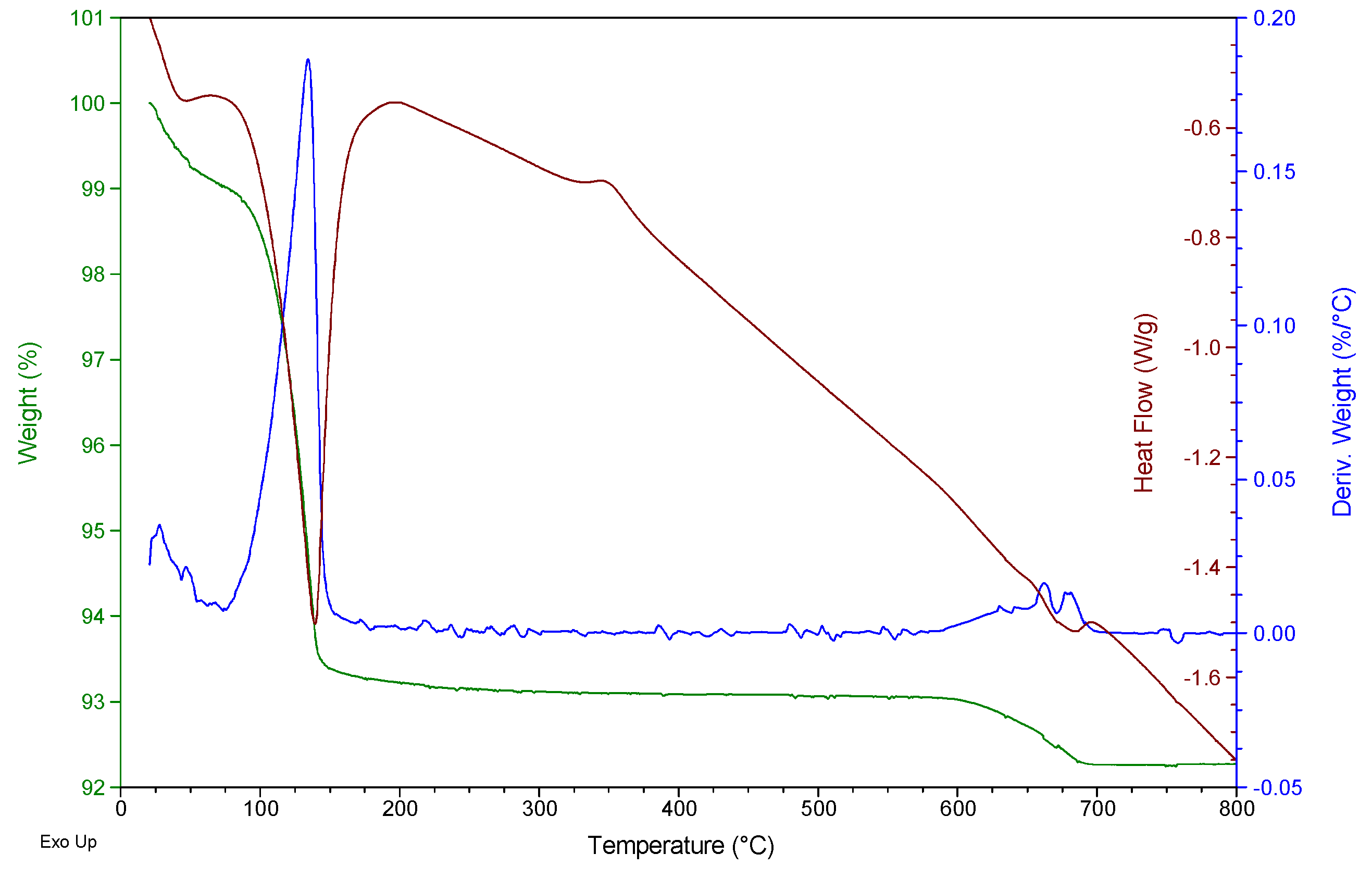
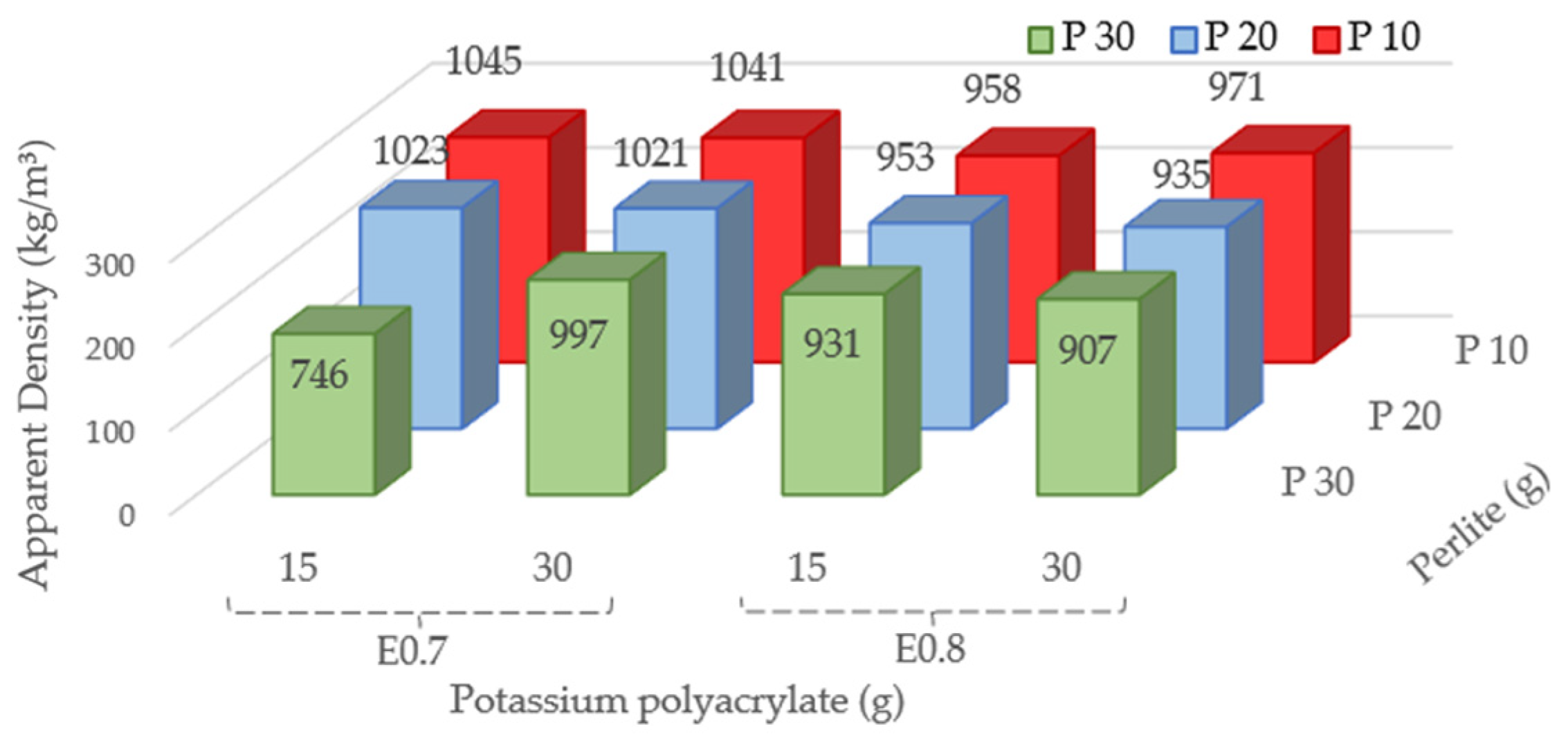

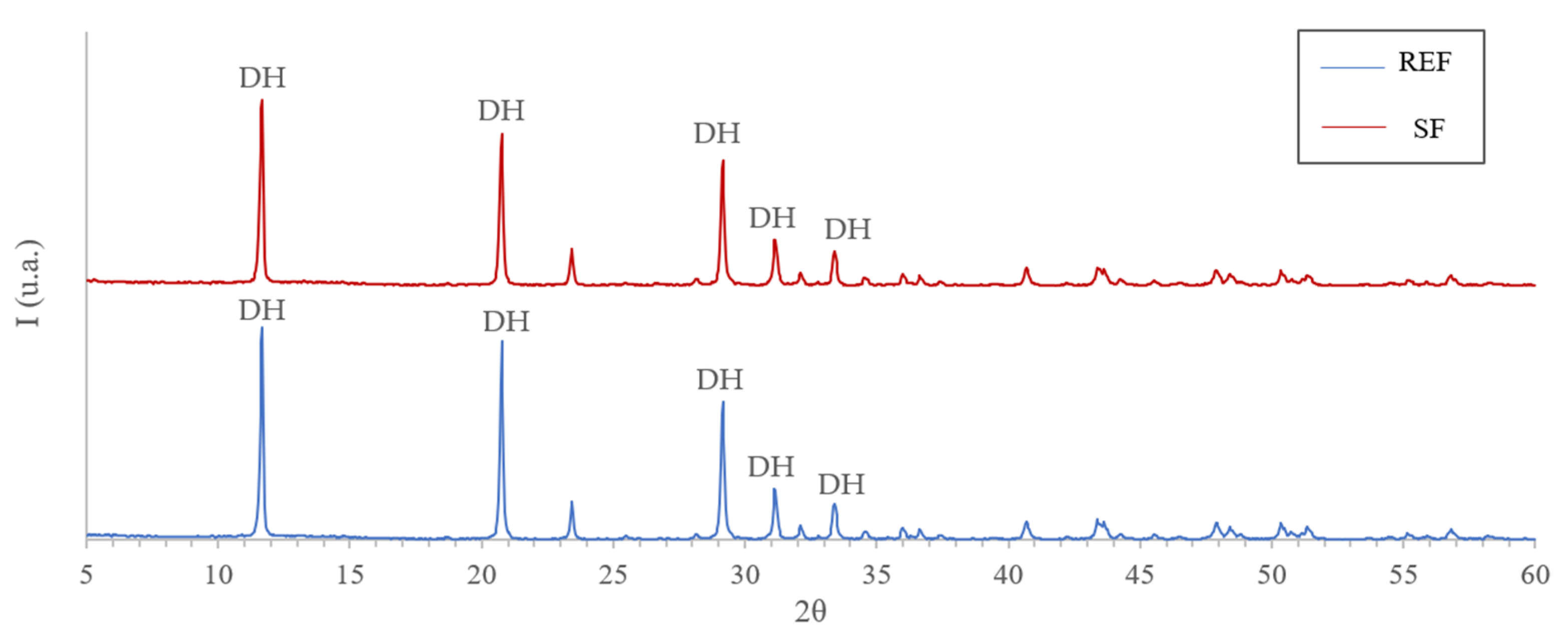
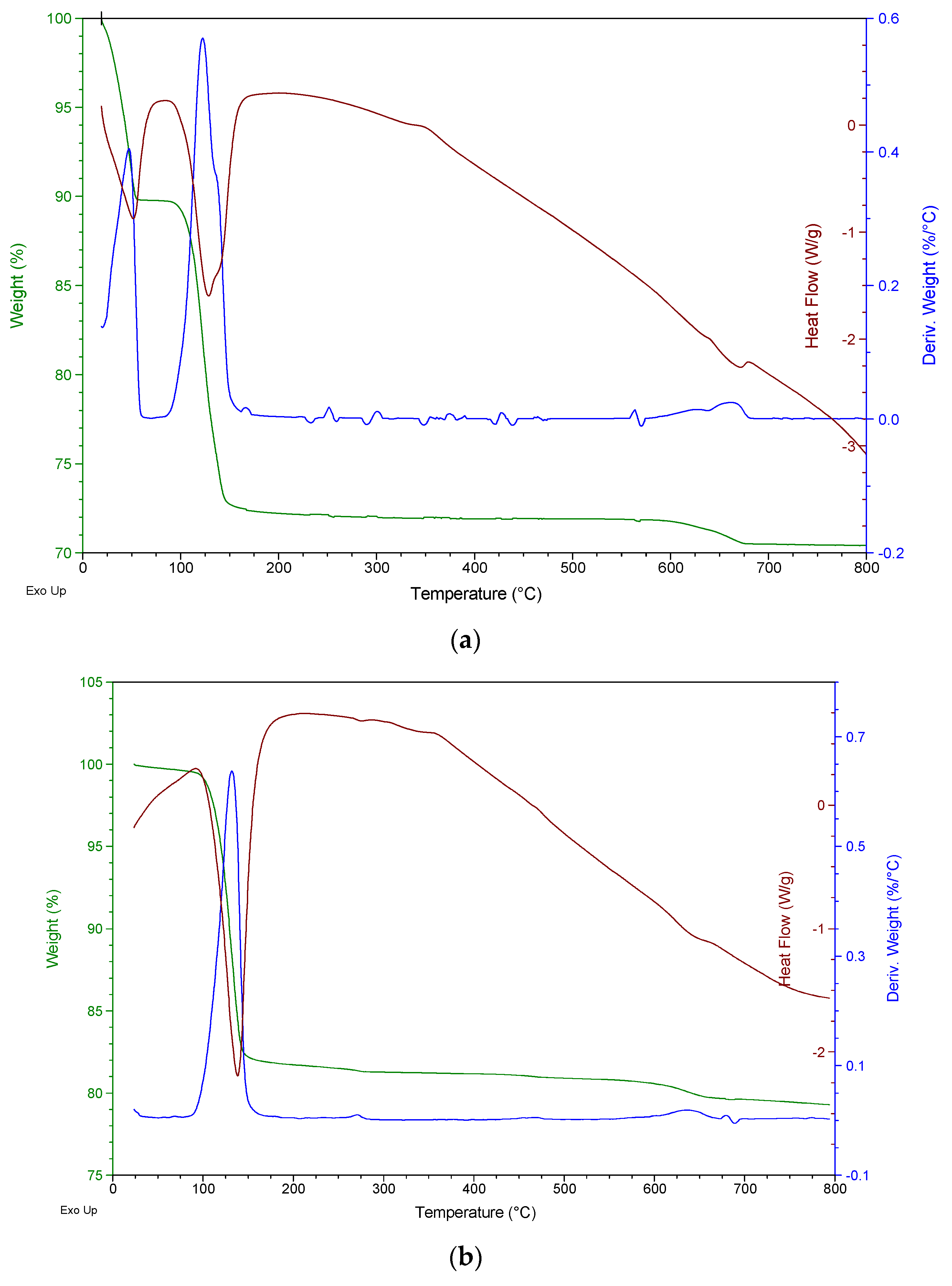

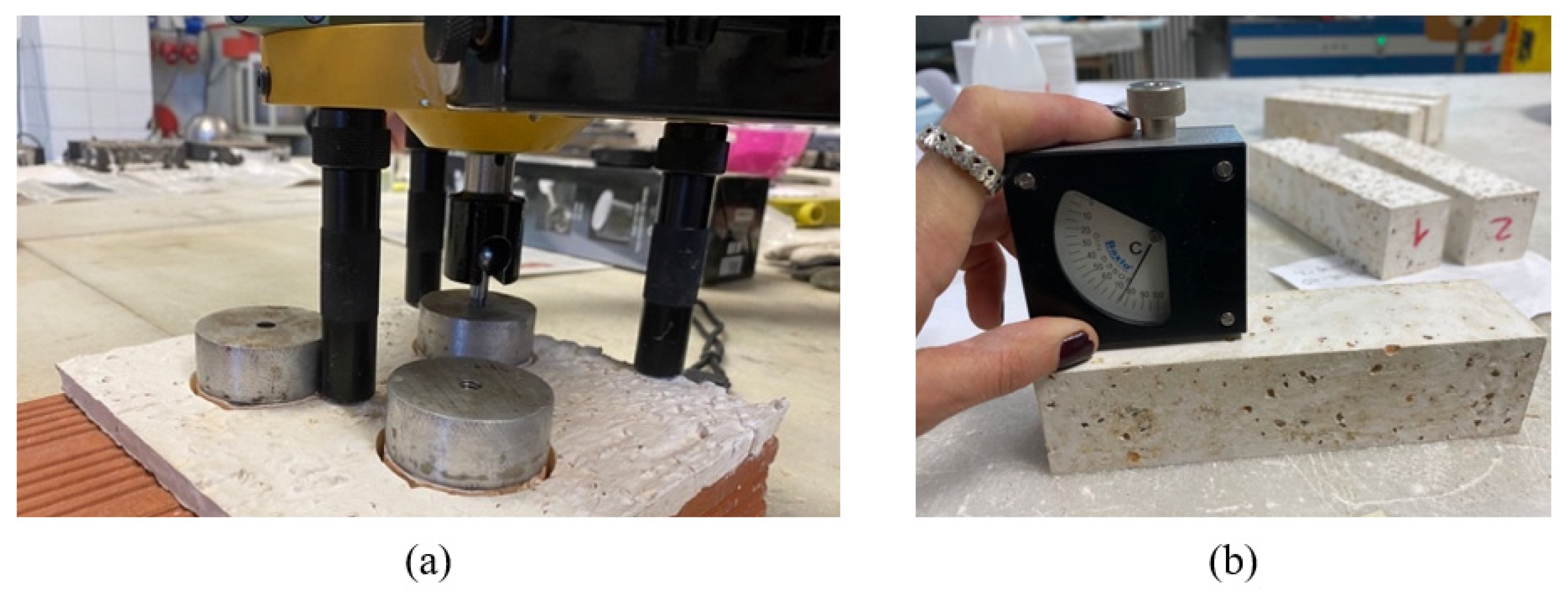
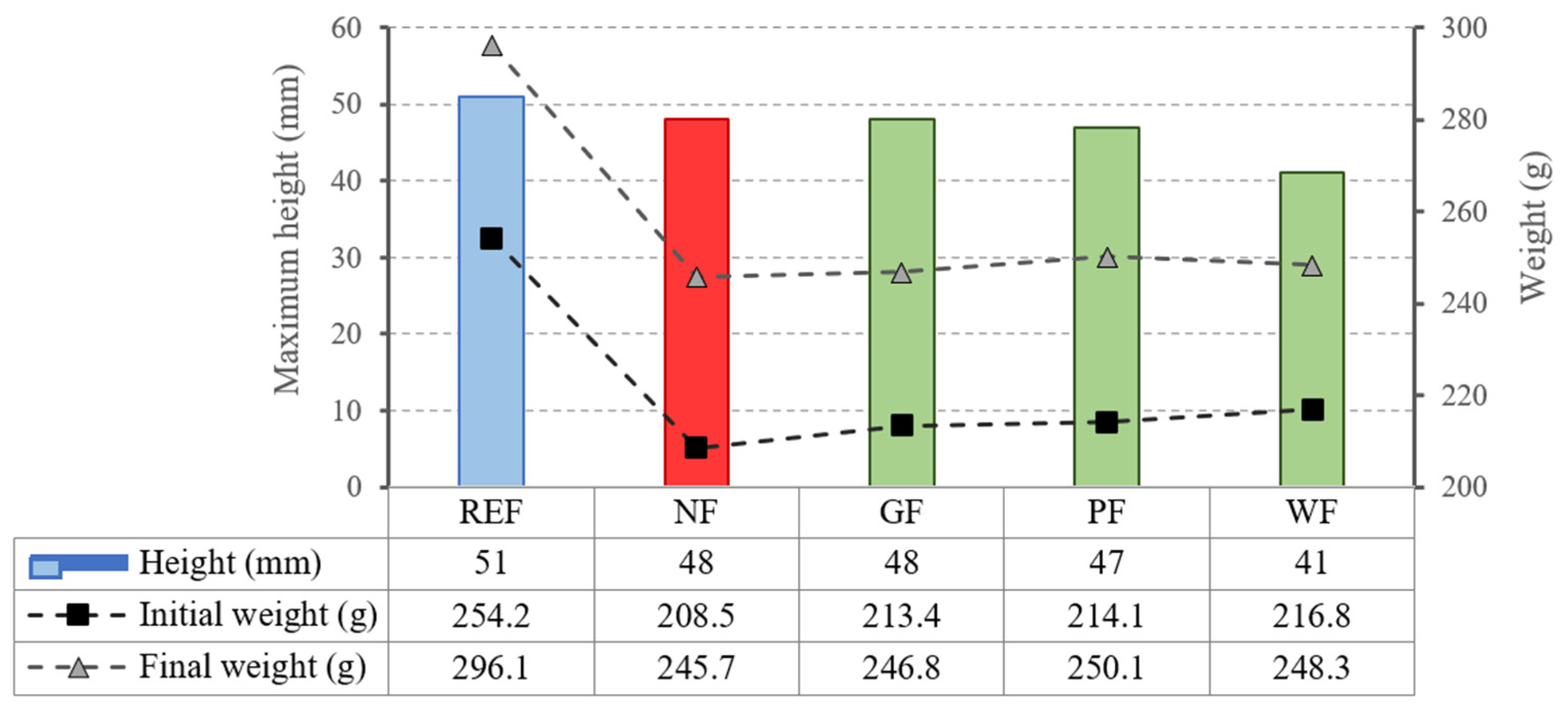
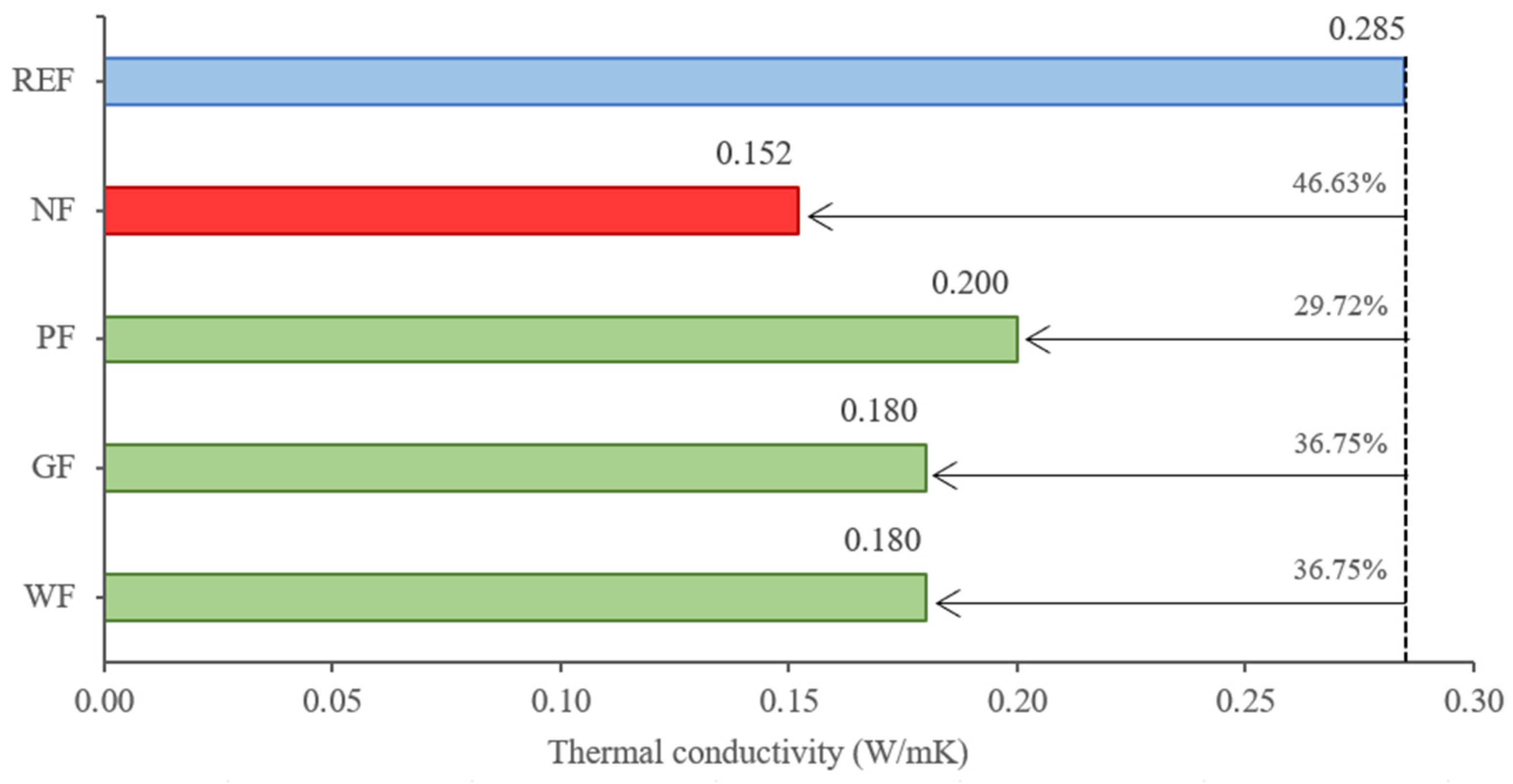
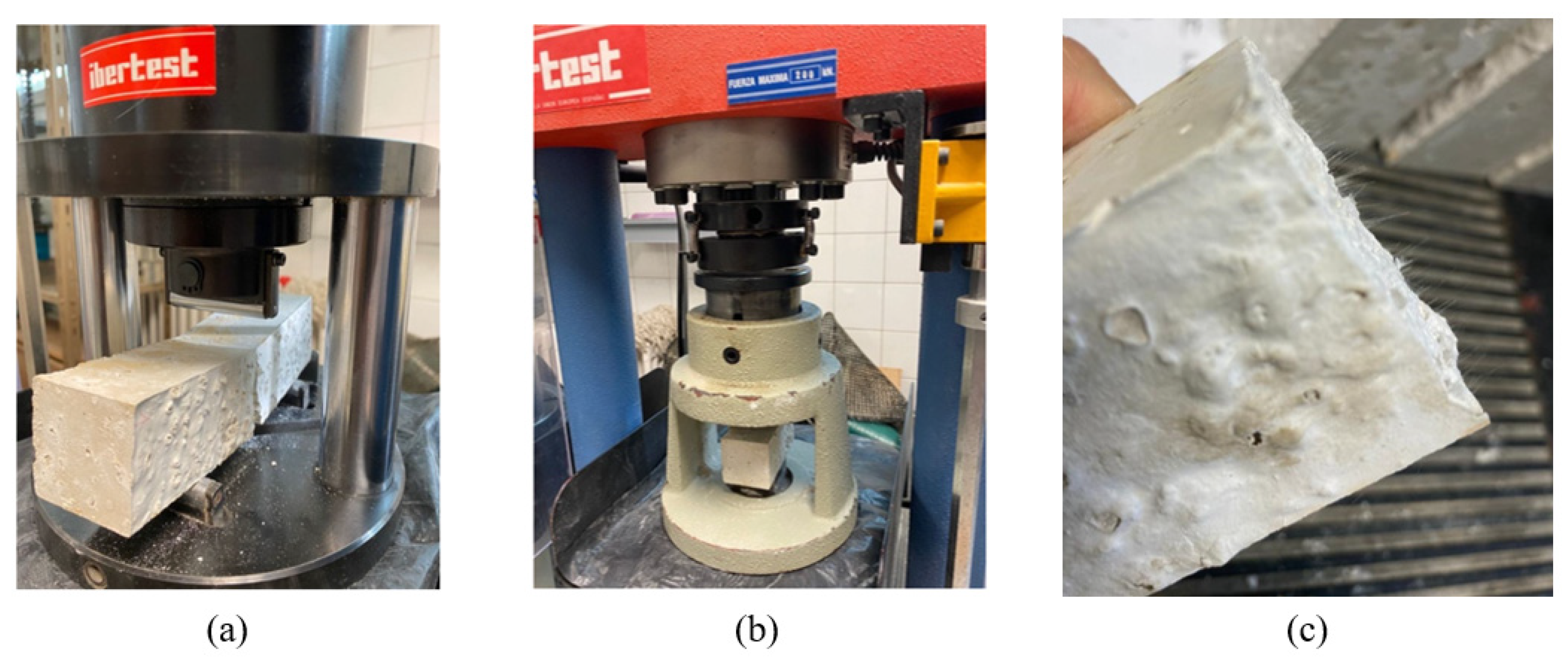
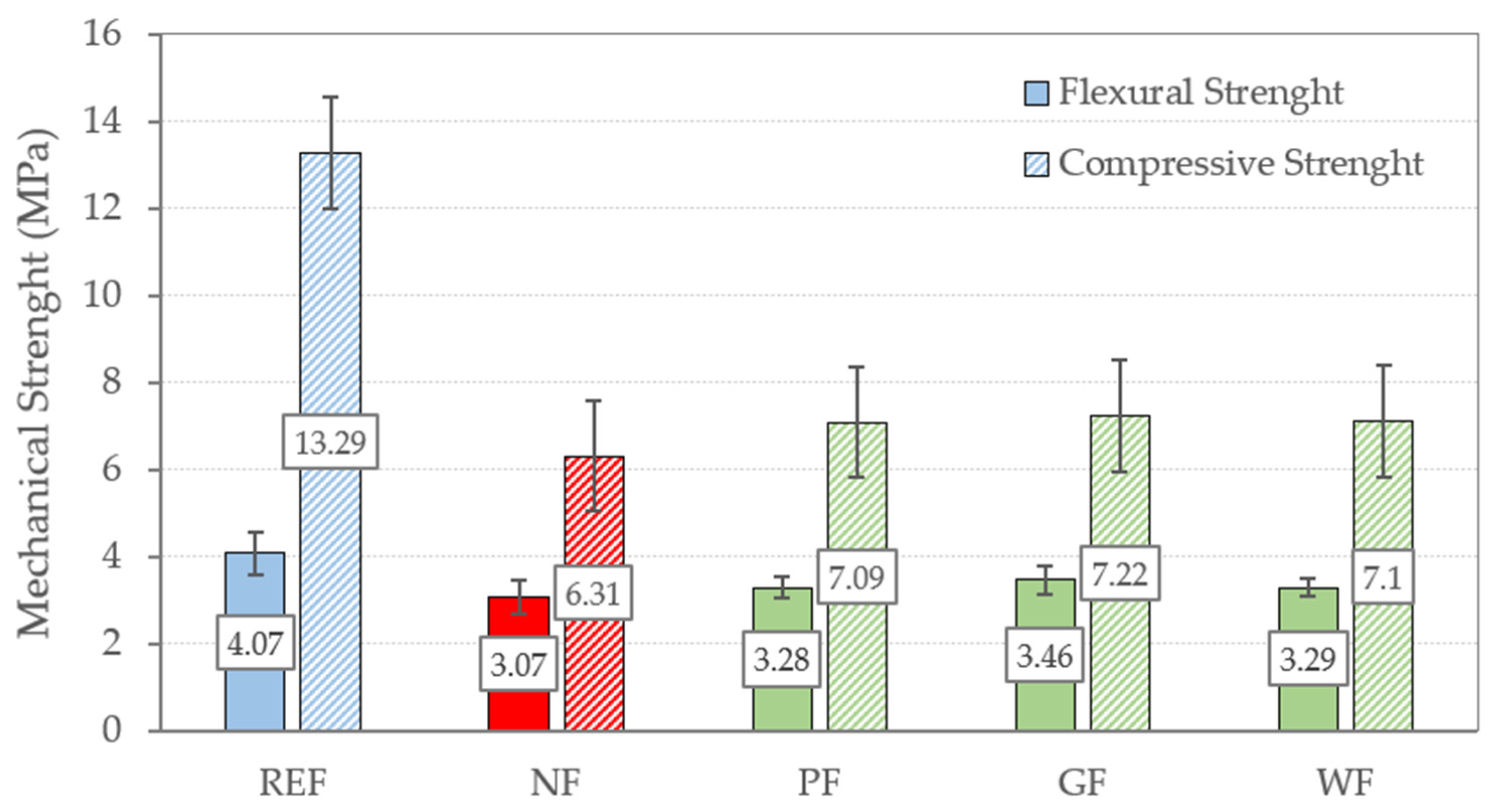
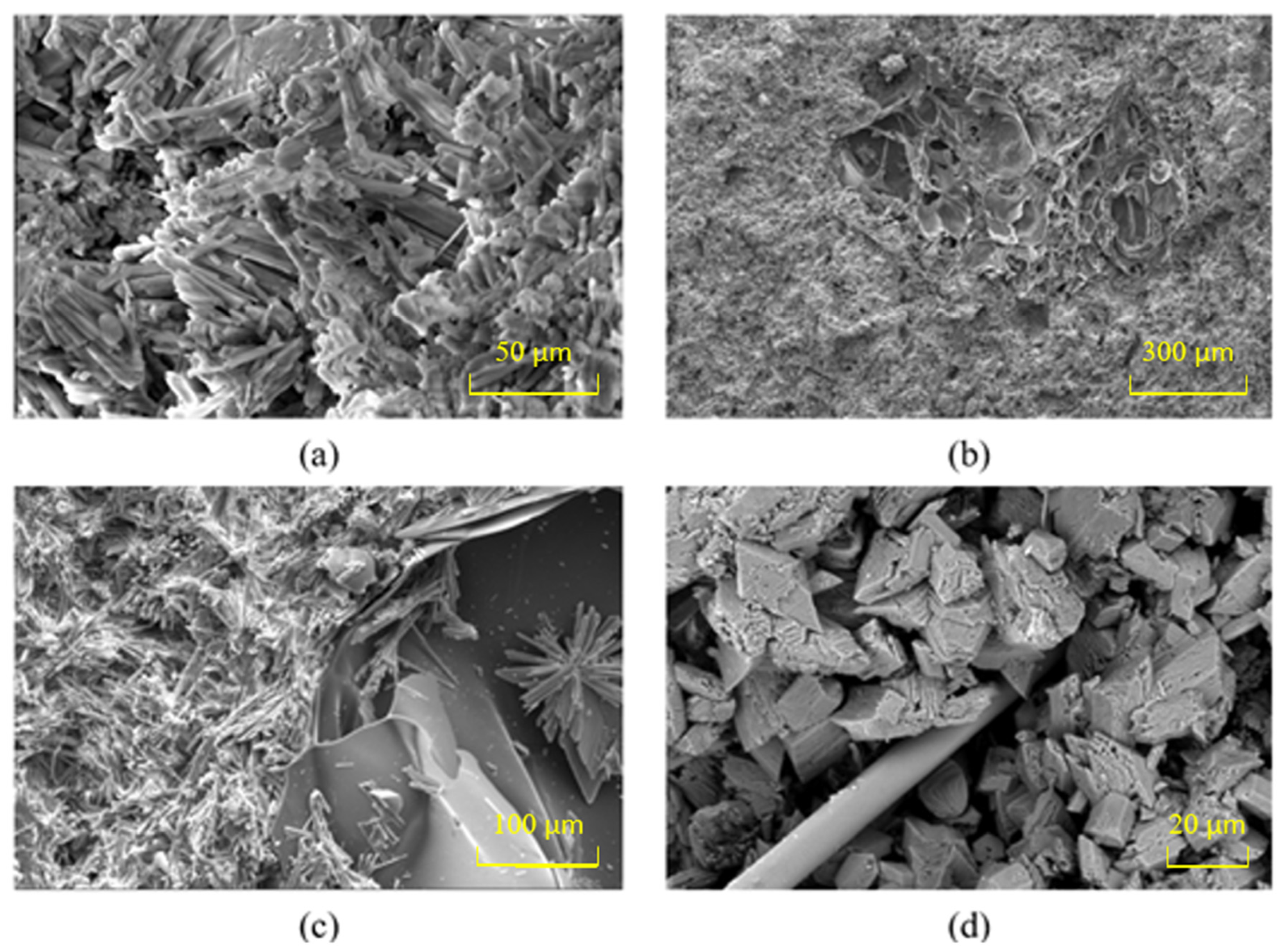


| Water/Dust Ratio | Fire Resistance (*) | Granulometry | Thermal Conductivity (W/mK) | Bending Strength (MPa) | Purity Rate (%) |
|---|---|---|---|---|---|
| 0.7–0.8 | A1 * | 0–0.2 mm | 0.3 | >3 | >90 |
| Hardness | pH | Chloride Content | |||
|---|---|---|---|---|---|
| 25 mg CaCO3/L | 7.0–8.5 | 1.0–1.5 mg/L | |||
| Main chemical compounds | |||||
| Nitrites (<0.05 mg/L) | Nitrates (0.6 mg/L) | Sulphates (5.3 mg/L) | Calcium (17.8 mg/L) | ||
| Origin | Fiber | Density (kg/m3) | Modulus of Elasticity (GPa) | Tensile Strength (GPa) | Elongation at Fracture (%) | Length (mm) |
|---|---|---|---|---|---|---|
| Synthetic | Glass | 2680 | 72 | 1.7 | 4.3 | 12 |
| Polypropylene | 910 | 6 | 0.4 | 80–140 | 12 | |
| Natural | Wood | 589 | 12 | 7.0 (*) | 30–50 | 12 |
| Sample | Water | Plaster | (C3H3KO2)n | Perlite | Sample | Water | Plaster | (C3H3KO2)n | Perlite |
|---|---|---|---|---|---|---|---|---|---|
| E0.7 | 700 | 1000 | 0 | 0 | E0.8 | 800 | 1000 | 0 | 0 |
| E0.7-15-10 | 700 | 1000 | 15 | 10 | E0.8-15-10 | 800 | 1000 | 15 | 10 |
| E0.7-15-15 | 700 | 1000 | 15 | 20 | E0.8-15-20 | 800 | 1000 | 15 | 20 |
| E0.7-15-20 | 700 | 1000 | 15 | 30 | E0.8-15-30 | 800 | 1000 | 15 | 30 |
| E0.7-30-10 | 700 | 1000 | 30 | 10 | E0.8-30-10 | 800 | 1000 | 30 | 10 |
| E0.7-30-15 | 700 | 1000 | 30 | 20 | E0.8-30-20 | 800 | 1000 | 30 | 20 |
| E0.7-30-20 | 700 | 1000 | 30 | 30 | E0.8-30-30 | 800 | 1000 | 30 | 30 |
| Sample | Bulk Density (kg/m3) | Flexural Strength (MPa) | Compressive Strength (MPa) |
|---|---|---|---|
| E0.7 | 1098.96 | 4.07 | 13.29 |
| E0.8 | 965.76 | 4.63 | 8.83 |
| Sample | Water (g) | Plaster (g) | (C3H3KO2)n | Perlite (g) | Fibers (g) | Setting Time (min) |
|---|---|---|---|---|---|---|
| REF | 700 | 1000 | — | — | — | 14:00 |
| NF | 700 | 1000 | 15 | 30 | — | 12:00 |
| GF | 700 | 1000 | 15 | 30 | 2.5 (glass) | 12:30 |
| PF | 700 | 1000 | 15 | 30 | 2.5 (polypropylene) | 12:30 |
| WF | 700 | 1000 | 15 | 30 | 7.0 (wood) | 11:00 |
| Sample | Bonding Strength (MPa) | Surface Hardness (Shore C) | Bulk Density (kg/m3) | Decrease Percentage of Density with Respect to Reference (%) |
|---|---|---|---|---|
| REF | 0.64 | 82 | 1198.96 | - |
| NF | 0.59 | 88 | 984.24 | 10.44 |
| GF | 0.48 | 88 | 992.84 | 9.66 |
| PF | 0.55 | 87 | 1004.82 | 8.57 |
| WF | 0.39 | 87 | 1010.94 | 8.01 |
| Sample | Elaborated Plasters | Mineral Wool Fibers [57] | Perlite [58] | Vermiculite [59] | Plastic Cables [15] | ||||
|---|---|---|---|---|---|---|---|---|---|
| REF | NF | GF | PF | WF | |||||
| Flexural Strength (MPa) | 4.07 | 3.07 | 3.28 | 3.46 | 3.29 | 4.11 | 2.25 | 2.45 | 2.67 |
| Compressive Strength (MPa) | 13.29 | 6.31 | 7.09 | 7.22 | 7.10 | 6.97 | 4-50 | 3.78 | 5.12 |
Disclaimer/Publisher’s Note: The statements, opinions and data contained in all publications are solely those of the individual author(s) and contributor(s) and not of MDPI and/or the editor(s). MDPI and/or the editor(s) disclaim responsibility for any injury to people or property resulting from any ideas, methods, instructions or products referred to in the content. |
© 2023 by the authors. Licensee MDPI, Basel, Switzerland. This article is an open access article distributed under the terms and conditions of the Creative Commons Attribution (CC BY) license (https://creativecommons.org/licenses/by/4.0/).
Share and Cite
Guijarro-Miragaya, P.; Ferrández, D.; Atanes-Sánchez, E.; Zaragoza-Benzal, A. Characterization of a New Lightweight Plaster Material with Superabsorbent Polymers and Perlite for Building Applications. Buildings 2023, 13, 1641. https://doi.org/10.3390/buildings13071641
Guijarro-Miragaya P, Ferrández D, Atanes-Sánchez E, Zaragoza-Benzal A. Characterization of a New Lightweight Plaster Material with Superabsorbent Polymers and Perlite for Building Applications. Buildings. 2023; 13(7):1641. https://doi.org/10.3390/buildings13071641
Chicago/Turabian StyleGuijarro-Miragaya, Patricia, Daniel Ferrández, Evangelina Atanes-Sánchez, and Alicia Zaragoza-Benzal. 2023. "Characterization of a New Lightweight Plaster Material with Superabsorbent Polymers and Perlite for Building Applications" Buildings 13, no. 7: 1641. https://doi.org/10.3390/buildings13071641
APA StyleGuijarro-Miragaya, P., Ferrández, D., Atanes-Sánchez, E., & Zaragoza-Benzal, A. (2023). Characterization of a New Lightweight Plaster Material with Superabsorbent Polymers and Perlite for Building Applications. Buildings, 13(7), 1641. https://doi.org/10.3390/buildings13071641









